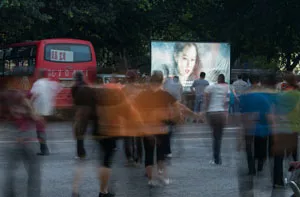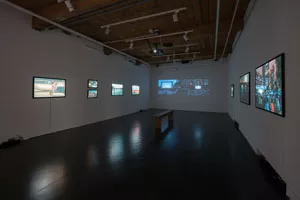
Projecting China: Photo series looks at China’s outdoor cinemas
Through photographs and film, U of T Mississauga historian Tong Lam has turned his lens on China, revealing much about the diversity of people and places in a rapidly changing nation.
Lam, who is an associate professor with UTM’s Department of Historical Studies and director of the Global Taiwan Program with U of T’s Munk School of Global Affairs & Public Policy, studies China’s modern and contemporary history with a focus on the intersection between technology and social culture. His latest research examines the historical and contemporary significance of mobile cinemas in rural China.
Mobile cinemas began in China in the 1950s as a way for the government to spread Communist messages to remote rural communities. “The state often took mobile cinemas to the countryside as a way to educate the people, but also as a form of propaganda,” Lam says, noting that early screenings often drew thousands of people from the surrounding area. “In the early days, rural people might not have had electricity and wouldn’t have experienced a loudspeaker and lights at night. The films were propaganda, but they were also entertainment and way to erase the difference between the city and the country.”

In 2012, Lam began a collaboration with historian Tina Chen of the University of Manitoba and filmmaker Thomas Lausen to learn more about the cinemas. The team travelled to China’s southwestern province of Sichuan to document modern mobile cinemas through photographs, interviews and film.
“We were embedded with projection teams, interviewing them and also talking to the audiences,” Lam says. “From the images, you can see that we are documenting a very diverse nation. There are different demographics—ages, classes, and groups of people—watching these films.”
Lam notes that, increasingly, the cinemas must compete with other screens, including illuminated billboards and personal cellphones. Yet despite the competition, the outdoor cinemas continue to draw crowds who come for many reasons—to see the movie, socialize with friends, drink in the dark or just to spend an evening outdoors. “Just like watching baseball isn’t always about watching baseball, the cinemas are about catching up with friends or drinking in a public space,” Lam says. “We see people watching, chatting and using their cell phones. They don’t really pay attention.”
“In the old days, thousands of people would come, sometimes walking for days to see the spectacle. But now, people don’t really care about the film—they’re dancing around the screen and playing with kids. It’s a different atmosphere.”

“Mobile cinema has become like a window to think about disparity in China, and about the global media landscape,” he says. “LED screens might show state propaganda and commercials, and it’s not clear where it ends. It all becomes the same thing—the Communist Party and luxury cars and jewelry.”
The team exhibited the project at the 2019 Scotiabank CONTACT Photography Festival in an exhibit that featured Lam’s large-format photos mounted in glowing lightboxes alongside vintage cinema equipment and projections of new and archival footage of the cinemas. A book of photos is also planned.
Funding for the project is provided by the Social Sciences and Humanities Research Council and the University of Toronto.
